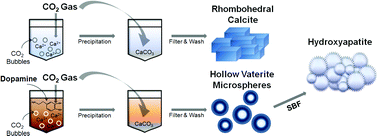Bio-inspired mineralization of CO2 gas to hollow CaCO3 microspheres and bone hydroxyapatite/polymer composites†
Abstract
We present the utilization of gaseous

* Corresponding authors
a
Department of Materials Science and Engineering, KAIST, Science Road 335, Yuseong-gu, Daejeon, Republic of Korea
E-mail:
parkcb@kaist.ac.kr
Fax: +82 42 350 3310
Tel: +82 42 350 3340
We present the utilization of gaseous

 Please wait while we load your content...
Something went wrong. Try again?
Please wait while we load your content...
Something went wrong. Try again?
S. Kim, J. W. Ko and C. B. Park, J. Mater. Chem., 2011, 21, 11070 DOI: 10.1039/C1JM12616D
To request permission to reproduce material from this article, please go to the Copyright Clearance Center request page.
If you are an author contributing to an RSC publication, you do not need to request permission provided correct acknowledgement is given.
If you are the author of this article, you do not need to request permission to reproduce figures and diagrams provided correct acknowledgement is given. If you want to reproduce the whole article in a third-party publication (excluding your thesis/dissertation for which permission is not required) please go to the Copyright Clearance Center request page.
Read more about how to correctly acknowledge RSC content.
 Fetching data from CrossRef.
Fetching data from CrossRef.
This may take some time to load.
Loading related content
